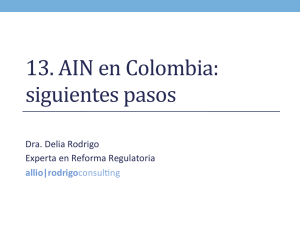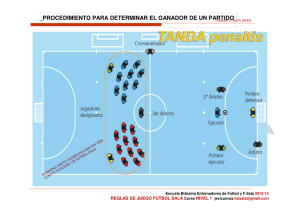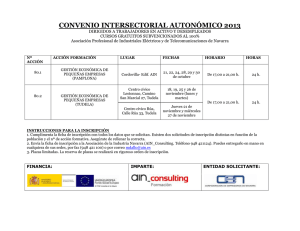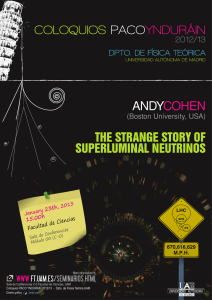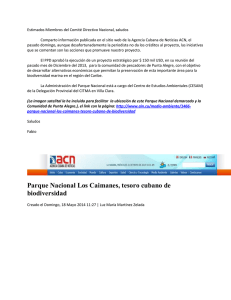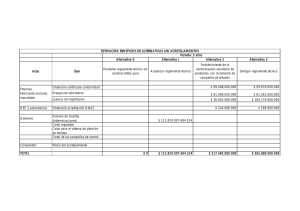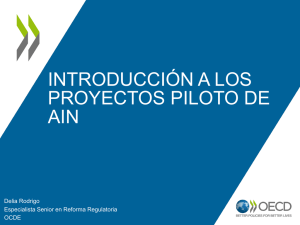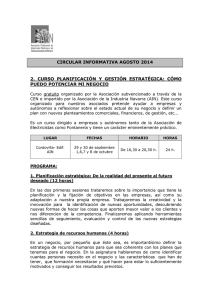neurología
Anuncio
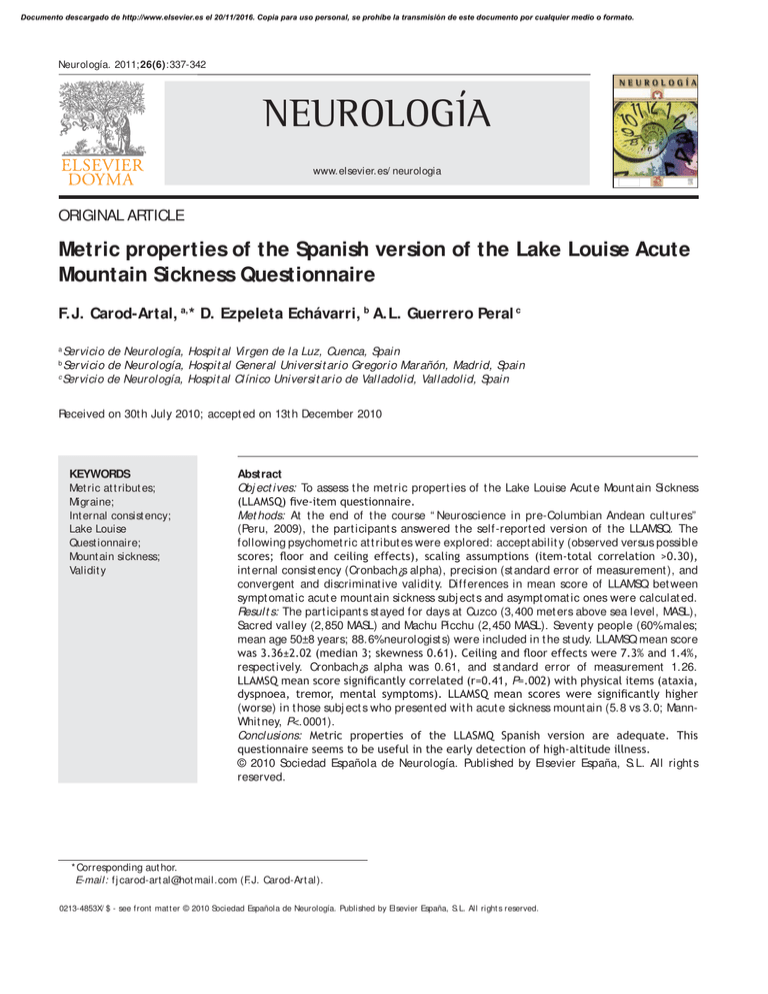
Documento descargado de http://www.elsevier.es el 20/11/2016. Copia para uso personal, se prohíbe la transmisión de este documento por cualquier medio o formato. Neurología. 2011;26(6):337-342 NEUROLOGÍA NEUROLOGÍA www.elsevier.es/ neurologia Publicación Oicial de la Sociedad Española de Neurología Volumen 25 • Número 1 • Enero-Febrero 2010 25 años ORIGINAL ARTICLE Metric properties of the Spanish version of the Lake Louise Acute Mountain Sickness Questionnaire F.J. Carod-Artal, a, * D. Ezpeleta Echávarri, b A.L. Guerrero Peral c a Servicio de Neurología, Hospit al Virgen de la Luz, Cuenca, Spain Servicio de Neurología, Hospit al General Universit ario Gregorio Marañón, Madrid, Spain c Servicio de Neurología, Hospit al Clínico Universit ario de Valladolid, Valladolid, Spain b Received on 30t h July 2010; accept ed on 13t h December 2010 KEYWORDS Met ric at t ribut es; Migraine; Int ernal consist ency; Lake Louise Quest ionnaire; Mount ain sickness; Validit y Abstract Obj ect ives: To assess t he met ric propert ies of t he Lake Louise Acut e Mount ain Sickness (LLAMSQ) ive-item questionnaire. Met hods: At t he end of t he course “ Neuroscience in pre-Columbian Andean cult ures” (Peru, 2009), t he part icipant s answered t he self-report ed version of t he LLAMSQ. The following psychomet ric at t ribut es were explored: accept abilit y (observed versus possible scores; loor and ceiling effects), scaling assumptions (item-total correlation >0.30), int ernal consist ency (Cronbach¿s alpha), precision (st andard error of measurement ), and convergent and discriminat ive validit y. Differences in mean score of LLAMSQ bet ween sympt omat ic acut e mount ain sickness subj ect s and asympt omat ic ones were calculat ed. Result s: The part icipant s st ayed for days at Cuzco (3,400 met ers above sea level, MASL), Sacred valley (2,850 MASL) and Machu Picchu (2,450 MASL). Sevent y people (60% males; mean age 50±8 years; 88.6%neurologist s) were included in t he st udy. LLAMSQ mean score was 3.36±2.02 (median 3; skewness 0.61). Ceiling and loor effects were 7.3% and 1.4%, respect ively. Cronbach¿s alpha was 0.61, and st andard error of measurement 1.26. LLAMSQ mean score signiicantly correlated (r=0.41, P=.002) with physical items (ataxia, dyspnoea, tremor, mental symptoms). LLAMSQ mean scores were signiicantly higher (worse) in t hose subj ect s who present ed wit h acut e sickness mount ain (5.8 vs 3.0; MannWhit ney, P<.0001). Conclusions: Metric properties of the LLASMQ Spanish version are adequate. This questionnaire seems to be useful in the early detection of high-altitude illness. © 2010 Sociedad Española de Neurología. Published by Elsevier España, S.L. All right s reserved. * Corresponding aut hor. E-mail: fj carod-art al@hot mail.com (F.J. Carod-Art al). 0213-4853X/ $ - see front mat t er © 2010 Sociedad Española de Neurología. Published by Elsevier España, S.L. All right s reserved. Documento descargado de http://www.elsevier.es el 20/11/2016. Copia para uso personal, se prohíbe la transmisión de este documento por cualquier medio o formato. 338 PALABRAS CLAVE At ribut os mét ricos; Cefalea; Consist encia int erna; Cuest ionario Lago Louise; Mal de alt ura; Validez F.J. Carod-Art al et al Propiedades métricas de la versión española del Cuestionario de Mal de Altura del Lago Louise Resumen Obj et ivos: Evaluar las propiedades mét ricas de la versión española del Cuest ionario de Mal de Alt ura del Lago Louise (CMALL) aut oaplicado de 5 ít ems. Mét odos: Tras el curso-seminario «Neurociencia en las cult uras andinas precolombinas» (Perú, 2009), se entregó una encuesta a los participantes que incluía el CMALL. Se evaluó la acept abilidad de los ít ems (punt uaciones observadas vs valores posibles, efect os t echo y suelo), asunciones escalares (correlación ítem-total > 0,30), consistencia interna (alfa de Cronbach), precisión (error est ándar de la medida) y validez de convergencia y discriminante. Esta última se evaluó calculando el valor medio del CMALL entre aquellos neurólogos que creían haber presentado mal de altura frente a quienes no lo habían present ado. Result ados: Est ancia por días en alt ura: Cuzco 3.400 m sobre el nivel del mar (msnm), Valle Sagrado (2.850 msnm) y Machu Picchu (2.450 msnm). Se incluyeron 70 suj et os (60% varones, edad media 50 ± 8 años, 88,6% neurólogos). El valor medio del CMALL fue 3,36 ± 2,02 (mediana 3, asimet ría 0,61). Los efect os t echo y suelo fueron 7,3 y 1,4%. El alfa de Cronbach fue 0,61 y el error est ándar de la medida 1,26. El CMALL se correlacionó signiicativamente (r = 0,41, p = 0,002) con los ítems de exploración física (ataxia, disnea, temblor, síntomas mentales). Las puntuaciones del CMALL fueron signiicativamente mayores (peores) en quienes presentaron mal de altura (5,8 vs 3,0; Mann-Whitney, p < 0,0001). Conclusiones: Las propiedades mét ricas de la versión española del CMALL parecen ser adecuadas. Est e cuest ionario puede ser út il en la det ección precoz del mal de alt ura. © 2010 Sociedad Española de Neurología. Publicado por Elsevier España, S.L. Todos los derechos reservados. Introduction Exposure t o alt it ude in subj ect s who are not acclimat ised can cause acut e mount ain sickness, charact erised by a combinat ion of signs and sympt oms, many of t hem of a neurological nat ure, where headache is t he main sympt om. 1 Insomnia, fat igue, feeling of dizziness and inst abilit y, anorexia and nausea are also common. 2,3 The most serious forms of acut e mount ain sickness can cause high alt it ude cerebral oedema. In sympt omat ic subj ect s, t here is usually a cert ain individual suscept ibilit y, as well as a lack of prior acclimat isat ion. 4 Some people can somet imes present high alt it ude headache, where t he headache occurs above 2,500m and cannot be at t ribut ed t o any ot her cause. 5 The diagnost ic crit eria for alt it ude headache according t o t he second edit ion Int ernat ional Headache Societ y6 classiication are summarised in t able 1. There are currently no adapted questionnaires in Spain t o assess acut e mount ain sickness. The aim of t his st udy was t o analyse t he met ric propert ies of t he Spanish version of the Lake Louise Acute Mountain Sickness (LLAMSQ) ive-item self-report ed Quest ionnaire, which is t he most commonly known and used questionnaire for detecting acute mountain sickness. 7 The direct applicat ion of t he English version of the questionnaire, with no prior adaptation to other languages or cult ural cont ext s, can cause diagnost ic failures. 8 There are other more complex questionnaires that assess acut e mount ain sickness, such as t he Environment al Sympt oms Quest ionnaire (ESQ), consist ing of 67 it ems wit h Acut e Mount ain Sickness subscales and Respirat ory Sympt oms. 9,10 Unlike these more complex questionnaires, the LLAMSQ can be quickly applied to clinical practice. The scores obt ained are useful for screening by healt h personnel in a rescue process or t o make t reat ment and evacuat ion decisions high in t he mount ains. Methods Participants The individuals included in t he st udy were part icipant s in a neurological hist ory seminar-course “ Neuroscience in PreColumbian Andean Cult ures” held in Peru during February 2009. Once t he course was complet ed, t he part icipant s were handed a survey t hat collect ed socio-demographic dat a, pat hological hist ory, as well as t he LLAMSQ and Headache at High Alt it udes Quest ionnaire. Lake Louise Acute Mountain Sickness Questionnaire The Lake Louise AMS scoring syst em was made up of 2 sections, a questionnaire on symptoms and a section for clinical examinat ion. 7 Documento descargado de http://www.elsevier.es el 20/11/2016. Copia para uso personal, se prohíbe la transmisión de este documento por cualquier medio o formato. Met ric propert ies of t he Spanish version of t he Lake Louise Acut e Mount ain Sickness Quest ionnaire Table 1 339 Table 3 Assessment syst em for t he self-report ing Lake Louise Acut e Mount ain Sickness Quest ionnaire Diagnost ic crit eria for alt it ude headache A. Headache wit h at least 2 of t he following charact erist ics and t hat complies wit h crit eria C and D: 1. Bilat eral 2. Front al or front o-t emporal 3. Dull or oppressive quality 4. Mild t o moderat e int ensit y 5. Is aggravat ed by exercise, movement , effort , coughing or when bending over B. Ascent t o an alt it ude above 2,500m C. The headache develops during the irst 24hrs of the ascent D. The headache goes away in the irst 8hrs after the descent The symptoms questionnaire comprised 5 items on which t he part icipant s t hemselves could respond: Headache, Nausea and vomit ing, Fat igue/ t iredness, Dizziness/ confusion and Sleep Disorders (t able 2). The t ot al score of the questionnaire was 15 points and could be clinically useful when diagnosing and monit oring t he sympt oms of acut e mount ain sickness in people exposed t o it . Table 2 Individual it ems on t he self-report ing Lake Louise Acut e Mount ain Sickness Quest ionnaire Headache No headache Mild headache Moderat e headache Severe, incapacit at ing headache 0 1 2 3 Nausea and vomit ing No nausea and vomit ing Anorexia or mild nausea Moderat ely int ense nausea and/ or vomit ing Serious nausea and/ or vomit ing 0 1 2 3 Fat igue/ t iredness No fat igue or t iredness Mild fat igue or t iredness Moderat ely int ense fat igue or t iredness Serious fat igue or t iredness 0 1 2 3 Dizziness/ conf usion No dizziness Mild dizziness Moderat e dizziness Severe, incapacit at ing dizziness 0 1 2 3 Sleep disorders None I haven’ t slept as well as usual I woke up several t imes; I’ ve slept badly I’ ve hardly been able t o sleep at all 0 1 2 3 Clinical assessment A. Changes in ment al st at e No changes in ment al st at e Let hargy Disorient at ion or confusion St upor or unconsciousness B. At axia No at axia Carries out manoeuvres t o maint ain balance Falls to the loor Cannot remain st anding C. Peripheral oedema No peripheral oedema Peripheral oedema in one place Peripheral oedema in t wo or more places Functional score Overall, if you have had any sympt oms, how much did it af f ect your act ivit ies? No reduct ion in act ivit ies Slight reduct ion in act ivit ies Moderat e reduct ion in act ivit ies Severe reduct ion in act ivit ies 0 1 2 3 0 1 2 3 0 1 2 3 0 1 2 3 Acut e Mount ain Sickness diagnosis is primarily based on t he presence of a main sympt om, t he headache —even if mild—which is associat ed t o a st ay at high alt it ude over t he previous few days wit h t he presence of at least one ext ra symptom and a score of 3 or more in the questionnaire. A score of 3 t o 5 shows mild acut e mount ain sickness and a score of 6 or more shows severe acut e mount ain sickness. The questionnaire of symptoms can be carried out via a clinical int erview, or more commonly wit h a self-report ed one. The self-report ing version of LLAMSQ adapt ed t o Spanish was t he subj ect of t his st udy, wit h lat er psychomet ric analysis. The scale was adapt ed and t ranslat ed (EnglishSpanish) by t he aut hors in search of a bet t er semant ic adapt at ion wit h t he purpose of making a correct applicat ion of it wit hout inducing comprehension errors in t he it ems used. The second part of t he assessment syst em (a clinical examinat ion t hat can be carried out by individuals on t heir own, but t hat is normally carried out by t rained healt h st aff) is useful t o ident ify t he progress of acut e mount ain sickness t owards alt it ude cerebral oedema aft er ment al st at e, at axia and presence of peripheral oedema is assessed. This part includes a funct ional score t hat assesses t he impact of any sympt om on everyday life act ivit ies (t able 3). Psychometric analysis The following met ric propert ies for LLAMSQ were assessed: quality of the data and acceptability of the items, scaling assumpt ions, reliabilit y, precision and validit y. 11 We will briely explain below what these metric properties are comprised of. Documento descargado de http://www.elsevier.es el 20/11/2016. Copia para uso personal, se prohíbe la transmisión de este documento por cualquier medio o formato. 340 Accept abilit y is t he met ric propert y t hat analyses if t he dist ribut ion of t he scores in a scale represent s t he real dist ribut ion of t he st at e of healt h or disease of t he sample. Accept abilit y was assessed t hrough dist ribut ion analysis and a score range, scores observed vs possible LLAMSQ values and loor and ceiling effects. The last terms refer to the percent age of individuals t hat score in ext reme LLAMSQ values (minimum and maximum score obt ained respect ively, which should be less t han 15%). 12 Scaling assumpt ions refer t o checking t he correct grouping of t he it ems in t he LLAMSQ. They also assess if t he sum of t he 5 it ems is appropriat e t o produce t he t ot al score of t he const ruct “ suffering from acut e mount ain sickness,” which we are t rying t o measure. Scaling assumpt ions are checked via t he t ot al correct ed it em-score correlat ion, avoiding t he inclusion of t he it em it self in t he t ot al. The t ot al correct ed LLAMSQ item-score should be greater than or equal to 0.3013 (Spearman’s correlation coeficient). Reliability is the property indicating that the questionnaire is free from random error. Int ernal consist ency, t oget her wit h reproducibilit y, is a fundament al feat ure of t his met ric at t ribut e. The int ernal consist ency of LLAMSQ was assessed using Cronbach’s alpha. An accept able int ernal consist ency was considered as values above 0.7. 14 Precision refers to the ability of the questionnaire to det ect small differences. This met ric at t ribut e is expressed in a st andard measurement error form, which is calculat ed wit h t he following formula: st andard error of t he measurement=standard deviation x √(1-reliability coeficient).15 The validit y of t he ext ernal const ruct refers t o t he combinat ion of st rat egies used t o est ablish validit y of a measurement inst rument t hrough a series of procedures t hat analyse t he relat ionship of t he score obt ained wit h ot her similar ones. For t his, convergent validit y and discriminat ive validit y have t o be det ermined at t he same t ime. 16 Convergent validit y is t he level t o which a scale correlat es wit h t he result s obt ained wit h ot her measurement s for t he same const ruct . 17 For t his, we calculat ed Spearman’s correlation coeficient (rS) bet ween t he mean LLAMSQ score wit h a set of self-report ing it ems creat ed by t he aut hors (t able 4: Ment al sympt oms, at axia, dyspnoea and t remor), which were assessed at t he same t ime as t he acut e mount ain sickness scale was applied. The a priori hypot heses est ablished was t hat t hese correlat ions wit h t he neurological self-examining it ems would be moderat e (r S=0.30–0.59). Discriminat ive validit y refers t o t he capacit y of t he measurement inst rument (LLAMSQ) t o det ect differences at a point in t ime bet ween groups t hat are different in ot her measurement s. Discriminat ive validit y was assessed calculat ing t he mean LLAMSQ score bet ween t hose neurologist s who t hought t hey had present ed acut e mount ain sickness against t hose who report ed not having had it. The 2 questions used were the following: Do you t hink you have suffered from acut e mount ain sickness? Do you t hink you have part ially suffered from acut e mount ain sickness? The mean scores obt ained in t he LLAMSQ in bot h groups were compared using t he Mann-Whit ney U t est . The st at ist ical analysis was carried out using t he SPSS 13.0 programme (SPSS, Chicago, IL). F.J. Carod-Art al et al Table 4 Ext ernal clinical assessment it ems used t o measure t he convergent validit y of t he self-report ing Lake Louise Acut e Mount ain Sickness Quest ionnaire Ment al sympt oms None Mild at t ent ion disorder, slight slowness in t hinking Moderate bradypsychia, frequent disorientation Inabilit y t o ret ain informat ion, confusion, hallucinat ions At axia None Mild, wit h an occasional st umble or manual clumsiness Moderat e, wit h obvious clumsiness in walking or when using hands Serious, needs help t o walk or eat Dyspnoea No respiratory dificulty Dyspnoea wit h moderat e exercise (going up a hill) Dyspnoea wit h slight exercise (walking on t he level) Rest ing dyspnoea Tremor None Slight tremor (makes signing dificult or condit ions it ) Moderate tremor (makes using cutlery dificult) Serious t remor (incapacit at ing) 0 1 2 3 0 1 2 3 0 1 2 3 0 1 2 3 Results Sevent y Caucasian Spanish people, who had not previously lived in geographical regions of alt it ude, t ook part in t he st udy. The mean alt it ude t hey normally lived at was 409.7m above sea level. There was a percent age of 60% who were male, a mean age of 50±8 years and 88.6%of t he part icipant s were neurologist s. Their mean weight was 74.4±15.2kg and mean height was 170.3±8.7cm. There was a 31%percent age rat e of part icipant s who present ed migraine and 15.7% smoked. There were no people who had act ive or sympt omat ic pulmonary disease. The questionnaire was carried out after the course had inished. Of the subjects, 16% recognised having suffered from acut e mount ain sickness and 36.2%a part ial form of it . The irst 2 days of the course took place in Lima, at sea level. The st ay in alt it ude over t he next days was as follows: Cuzco (2 days and 2 night s), 3,400 met res above sea level (MASL); Valle Sagrado (a day and a night ), 2,850 MASL; and Machu Picchu (a day), 2,450 MASL. The physical act ivit y carried out during t he st ay on t he neurological hist ory course was moderat e, t he part icipant s did not undert ake mount ain crossings and t hey had no previous exposure t o moderat e or high alt it udes. The LLAMSQ mean score was 3.36±2.02 (median, 3; skewness, 0.61). The range of values observed swung from Documento descargado de http://www.elsevier.es el 20/11/2016. Copia para uso personal, se prohíbe la transmisión de este documento por cualquier medio o formato. Met ric propert ies of t he Spanish version of t he Lake Louise Acut e Mount ain Sickness Quest ionnaire 0 to 10 (possible range: 0-15). The loor and ceiling effects were 7.3 and 1.4%respect ively. The correct ed it em-t ot al correlat ion (Spearman coeficient) was: 0.27 (sleep item), 0.33 (dizziness item), 0.34 (nausea it em), 0.39 (headache it em) and 0.57 (t iredness it em). The Cronbach alpha score was 0.61 and t he st andard error of t he measurement , 1.26. The eliminat ion of it em 5 (sleep) improved t he Cronbach alpha score by 0.63. Wit h relat ion t o t he convergent validit y, t he LLAMSQ correlated signiicantly with the items of physical selfexaminat ion: at axia, dyspnoea, t remor and ment al symptoms (r=0.41; P=0.002). The correlation between the dyspnoea and tiredness items was signiicant (r=0.39). The discriminat ive validit y was appropriat e. The scores obtained in the LLAMSQ were signiicantly greater (worse) in t he group of neurologist s t hat responded having suffered from acut e mount ain sickness (5.8 point s vs 3.0 point s; Mann-Whit ney U, P<0.0001). Discussion We present t he met ric propert ies of t he Spanish LLAMSQ version. The aut hors have not found a psychomet ric analysis process and st andardised validat ion in medical lit erat ure, in accordance t o t he modern psychomet ric t heories, of t he original English version. The LLAMSQ adapt at ion was carried out in a group of neurologist s exposed t o alt it ude wit h no previous acclimat isat ion. The sample could be represent at ive of a group of middle-aged individuals who t ravel t o areas of high alt it ude wit h no previous acclimat isat ion and not for sport ing reasons. The applicat ion of LLAMSQ in children and adolescent s can underest imat e t he sympt oms of acut e mount ain sickness. 18 The percent age of scores in t he ext reme values of t he scale (loor and ceiling effects) was small in LLAMSQ. There were no high values in t he scale because t here were no serious cases of acut e mount ain sickness and t here was no exposure t o alt it udes of more t han 4,000m. The int ernal consist ency found, according t o Cronbach’s alpha, was moderat e (0.63). This is part ly explained because t he value of Cronbach’s alpha is dependent on a number of it ems comprising a scale and decrease as t heir number in t he scale or cat egory is reduced. In a st udy of miners who were exposed t o alt it ude in Chile, t he Cronbach alpha value of LLAMSQ was 0.70. 19 The scaling assumpt ions of t he it ems were suit able and only t he sleep it em scored under 0.30. The t iredness it em presented the best item-questionnaire correlation. The fact t hat it was a middle aged populat ion, who did not pract ise physical act ivit ies regularly at high alt it ude, could have inluenced the result. However, tiredness can be a sensitive clinical symptom that is frequently associated to acute mount ain sickness. An import ant fact of t he score syst em is t hat it emphasises t he import ance of headache in t he deinition of acute mountain sickness. The item-total correlat ion for t he headache it em was great er t han t he crit eria est ablished (0.39). The st andard error of t he measurement was small. Theref ore, t he dif f erence in a point t hat could be obt ained f rom t wo dif f erent measurement s on t he scale could be 341 due to the error of measurement from the questionnaire it self . The LLAMSQ t est also has suit able discriminat ive validit y, given t hat t he scores obt ained show t hat t he individuals in t he sample who present ed acut e mount ain sickness symptoms scored worse in this questionnaire. The convergent validit y of t he Spanish version of LLAMSQ seems t o be equally correct. However, t his st udy present s some limit at ions. It was carried out among middle-aged people who were exposed t o alt it ude wit hout previous acclimat isat ion, t he maj orit y of whom were neurologist s; t his is why t he generalisat ion of the indings for other population groups could be limited. The analysis for convergent validit y wit h t he it ems of selfreport ing physical examinat ion might not be ext rapolat ive, as it deals wit h a t rained sample, and t he clinical assessment was carried out by t he neurologist s t hemselves subj ect t o t he t rial. Despit e being able t o assess whet her t hey present ed sympt oms of acut e mount ain sickness, an ext ernal clinical assessment t o est ablish t he diagnosis of acut e mount ain sickness would have been advisable. As t he acut e mount ain sickness sympt oms were not very severe, no self-report ing variables were used, such as t he percent age of oxygen sat urat ion and t he presence of cyanosis, for example. However, t he analysis of known groups suggest s t he validit y of t he scale. The variabilit y of t he dat a obt ained in our sample is limit ed, as t he maj orit y of t he individuals scored in t he lower t wo t hirds of t he scale. This is probably due t o t he fact t hat t he exposure t o alt it ude was moderat e. This fact could hinder t he assessment of t he behaviour of t he scale in individuals present ing more int ense acut e mount ain sickness. However, t he people in our st udy went from sea level alt it ude t o an alt it ude of more t han 3,500m wit hout any previous acclimat isat ion. We believe t hat t his change in alt it ude is indeed of value, mainly because t he scale is direct ed at people who oft en expose t hemselves t o a medium alt it ude wit hout acclimat isat ion and not t o an ext reme alt it ude. This st udy suggest s t hat t he Spanish version of LLAMSQ could be a suitable questionnaire to assess the symptoms of acut e mount ain sickness. The populat ion in which t he metric properties were assessed in the questionnaire was mainly composed of neurologist s. This is why we recommend new psychomet ric st udies t hat can analyse ot her met ric propert ies (reproducibilit y, sensit ivit y t o change), as well as t heir applicat ion t o ot her select ed reference groups (sport ent husiast s, mount aineers, young people and t he elderly) by combining t he use of ot her inst rument s t o assess acut e mount ain sickness. 20, 21 In t his t ype of st udies, an ext ernal clinical examinat ion for acut e mount ain sickness is recommended so as t o be able t o analyse sensit ivit y and speciicity. To conclude, the metric properties of LLAMSQ seem to be suitable. This self-reporting questionnaire could be useful for t he early det ect ion of acut e mount ain sickness. Conlict of interest The authors have no conlict of interest to declare. Documento descargado de http://www.elsevier.es el 20/11/2016. Copia para uso personal, se prohíbe la transmisión de este documento por cualquier medio o formato. 342 Acknowledgements We are grat eful t o all t he people who t ook part in t he neurological hist ory course “ Neuroscience in Pre-Columbian Andean Cult ures” held in Peru in 2009. References 1. Hacket t PH, Roach RC. High-alt it ude illness. N Engl J Med. 2001;345:107-14. 2. Silber E, Sonnenberg P, Collier DJ, Pollar AJ, Murdoch DR, Goadsby PJ. Clinical feat ures of headache at alt it ude. A prospect ive st udy. Neurology. 2003;60:1167-71. 3. Wilson MH, Newman S, Imray CH. The cerebral effect s of ascent t o high alt it udes. Lancet Neurol. 2009;8:175-91. 4. Pesce C, Leal C, Pint o H, González G, Maggiorini M, Schneider M, et al. Det erminant s of acut e mount ain sickness and success on Mount Aconcagua (6,962 m). High Alt Med Biol. 2005;6: 158-66. 5. Serrano Dueñas M. High alt it ude headache. A prospect ive st udy of it s clinical charact erist ics. Cephalalgia. 2005;25:1110-6. 6. Headache Classiication Committee of the International Headache Society. The International Classiication of Headache Disorders. 2nd edition. Cephalalgia. 2004;24 Suppl 1:S1–160. 7. Roach RC, Bart sch P, Hacket t PH, Oelz O, t he Lake Louise AMS Scoring Consensus commit t ee.The Lake Louise Acut e Mount ain Sickness scoring syst em. In: Sut t on JR, Houst on CS, Coat es G, edit ors. Hypoxia and Molecular Medicine. Burlingt on: Queen Cit y Press; 1993. p. 273-4. 8. Dellasant a P, Gaillard S, Lout an L, Kayser B. Comparing questionnaires for the assessment of acute mountain sickness. High Alt Med Biol. 2007;8:184-91. 9. Sampson JB, Kobrick JL. The environment al sympt oms questionnaire: revisions and new ield data. Aviat Space Environ Med. 1980;51:872-7. F.J. Carod-Art al et al 10. Sampson JB, Cymerman A, Burse RL, Maher JT, Rock PB. Procedures for t he measurement of acut e mount ain sickness. Aviat Space Environ Med. 1983;54:1063-73. 11. Mart ínez-Mart in P, Frades Payo B. Desarrollo de un inst rument o de valoración de calidad de vida relacionada con la salud. In: Mart ínez-Mart ín P, edit or. Calidad de vida en Neurología. Barcelona: Ars Medica; 2006. p. 33-48. 12. McHorney CA, Tarlov AR. Individual-pat ient monit oring in clinical practice:are available health surveys adequate? Qual Life Res. 1995;4:293-307. 13. In: Fayers PM, Machin D, editors. Quality of Life: Assessment, Analysis and Interpretation. Chichester: John Wiley & Sons; 2000. 14. Cronbach LJ. Coeficient alpha and the internal structure of t est s. Psychomet rika. 1951;16:297-334. 15. Scientiic Advisory Committee of the Medical Outcomes Trust. Assessing health status and quality-of-life instruments: Attributes and review crit eria. Qual Life Res. 2002;11:193-205. 16. Carod-Art al FJ, González-Gut iérrez JL, Egido-Herrero JA, Varela de Seij as E. Propiedades mét ricas de la versión española del peril de las consecuencias de la enfermedad de 30 ítems adapt ado al ict us (SIP30-AI). Rev Neurol. 2007;45:647-54. 17. Nunnally JC, Bernst ein IH. Psychomet ric t heory. New York: McGraw-Hill; 1994. 18. Sout hard A, Niermeyer S, Yaron M. Language used in Lake Louise Scoring Syst em underest imat es sympt oms of acut e mount ain sickness in 4- t o 11-year-old children. High Alt Med Biol. 2007;8:124-30. 19. Vera A, Sepúlveda R, Cont reras G. Aut o-Report e de Sínt omas Físicos y Correlat os Psicosociales en Trabaj adores de la Minería. Ciencia y Trabaj o. 2006;8:74-8. 20. Wagner DR, Tat sugawa K, Parker D, Young TA. Reliabilit y and ut ilit y of a visual analog scale for t he assessment of acut e mount ain sickness. High Alt Med Biol. 2007;08:27-31. 21. Maggiorini M, Müller A, Hofst et t er D, Bärt sch P, Oelz O. Assessment of acut e mount ain sickness by different score prot ocols in t he Swiss Alps. Aviat Space Environ Med. 1998;69: 1186-92.
